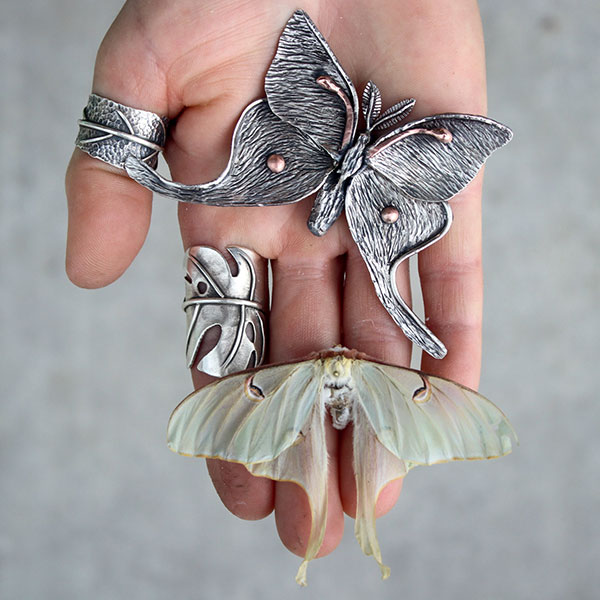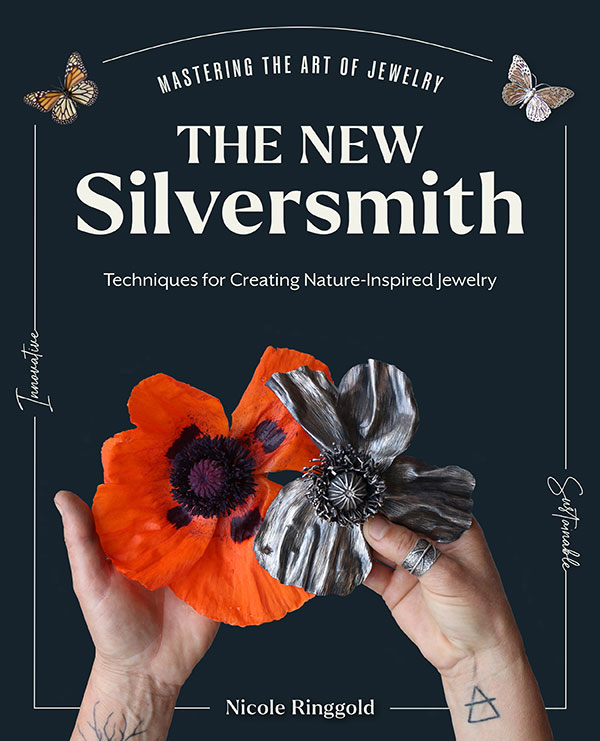
Nicole Ringgold’s book The New Silversmith: Techniques for Creating Nature-Inspired Jewelry is a metalworking must-have that highlights industry essentials while celebrating Ringgold’s innovative techniques that gained her fans on social media.
Out in June from Quarto, The New Silversmith also explains Ringgold’s zero-waste approach to jewelry-making, which she developed and teaches from her silversmithing studio in Winthrop, Wash., in the North Cascade Mountains.
“My goal with every piece is to make the metal appear alive,” Ringgold has said. On her website, she describes her process: “My intention is not to replicate the inspiration, but to re-create it with precious metal with as much detail as possible. My work is hand-fabricated. Many people assume that it is cast, dipped, or electroformed. I start with silver sheets and wire, saw, solder, file, texture, form, oxidize, and polish every piece.”
Ringgold tells JCK, “My book tells the story of my journey of discovery, outlines my self-inflicted challenges, and it shares a wide range of picture-instructed tutorials, all captured by my daughter, Cymone.”
The jewelry designer spoke more about the book and her silversmithing practices in our email interview.
Why did you want to write a book?
I’ve always dreamed of becoming an author. While growing up in Switzerland and hiking the Alps, I got through our long, steep treks by concocting winding, imagination-filled stories. My mind never slowed, and to this day I continuously dream up stories that beg to be written. Although I have finally accomplished my goal, this book is not a novel.

When I first ventured into silversmithing, I was determined to learn and find my own artistic voice within the millions of other jewelry artisans on social media. Unbeknownst to me, as I pushed my limits through a variety of self-challenges, I also taught myself how to “smith” in a way that supposedly cannot be done.
As I continued to teach around the globe, I felt it important that I be given credit for my self-discovered techniques that were becoming increasingly widespread across social media. It was too late for me to acquire copyright, so writing a book seemed to be the next best thing. Besides, I was excited to share my information with as many people as possible who might be interested in learning a new way of silversmithing.
You say this book challenges conventional wisdom—why do you recommend such a challenge?
I was never a straight-A student. In fact, I struggled in school and I was told by one of my teachers that I would never be more than a C-average student. It was my special-education teacher, who I devoted my book to, who helped me understand that art is a form of intelligence, and that perhaps I was more brilliant than standardized tests could ever reveal.
After that, I still grappled with mainstream education, managing to finally pursue a master’s degree, but never quite feeling adequate. As a teacher, I am determined to understand how each of my students learns so that I can help them be successful.
My entire journey as a silversmith has been to teach myself through self-challenges. I try new techniques myself before believing in impossibilities. It keeps my work from becoming monotonous or mundane. It has allowed me to discover my own artistic voice and separates me from the masses.
Now that I am a teacher, when a student asks me if something can be done, my response is “Let’s see if we can make it happen.” If I were to insist that something cannot be done, where is the empowerment in that message?
How did you become committed to zero-waste?
I was a young mother when I first began dabbling with metal. My daughter was only 7 years old, and I was concerned about having chemicals in our home. There are many alternatives to using chemicals when metalsmithing, so why not utilize the healthier approach?
I’m also a proponent of living a low-impact lifestyle. We live in the mountains where I can walk, bike, or ski to work almost every day. We try hard to support our local farmers and artisans, and maintain as close to a zero-waste home as possible. As someone with a larger following, I believe that it’s my responsibility to educate others about how we can sustain a small footprint on earth, and I must live by my own example.
Is your work still evolving?
Just after completing the manuscript, I discovered an entirely new technique that I would have included if I’d had the time. I am still experimenting, exploring, and learning. I am still pushing my own boundaries to see how far I can stretch. If this book is a success, I wonder if a second could follow.
Top: Some of metalsmith Nicole Ringgold’s nature-inspired, sustainably created jewelry pieces (photos courtesy of Nicole Ringgold)
Follow JCK on Instagram: @jckmagazineFollow JCK on Twitter: @jckmagazine
Follow JCK on Facebook: @jckmagazine





